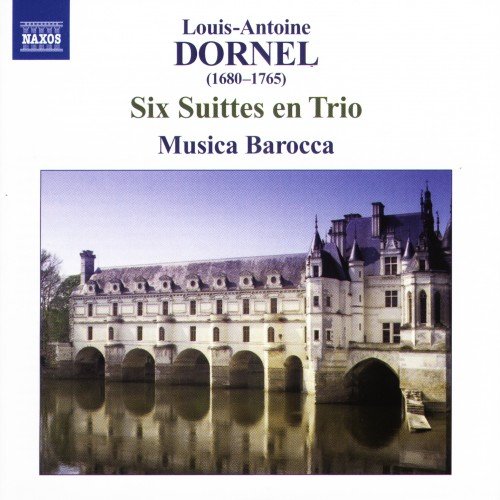Musica Barocca - Louis-Antoine Dornel - Six Suittes en Trio (2008)

Artist: Musica Barocca
Title: Louis-Antoine Dornel - Six Suittes en Trio
Year Of Release: 2008
Label: Naxos
Genre: Classical
Quality: FLAC (tracks+.cue,log,scans)
Total Time: 68:38
Total Size: 385 Mb
WebSite: Album Preview
Tracklist: Title: Louis-Antoine Dornel - Six Suittes en Trio
Year Of Release: 2008
Label: Naxos
Genre: Classical
Quality: FLAC (tracks+.cue,log,scans)
Total Time: 68:38
Total Size: 385 Mb
WebSite: Album Preview
Suitte en Trio No. 3 in E minor, Op. 1
01. I. Prelude
02. II. Allemande
03. III. Sarabande
04. IV. Gigue
05. V. Menuet - Menuet en Rondeau
06. VI. Passacaille
Suitte en Trio No. 2 in A major, Op. 1
07. I. Prelude
08. II. Allemande
09. III. Rondeau
10. IV. Sarabande
11. V. Fantaisie
12. VI. Chaconne
13. VII. Rigodons I and II
Suitte en Trio No. 4 in D major, Op. 1
14. I. Ouverture
15. II. Sarabande
16. III. Gavotte
17. IV. Chaconne
18. V. Rigodons I and II
Suite en Trio No. 1 in A minor, Op. 1
19. I. Overture
20. II. Air tendre
21. III. Rondeau
22. IV. Air en loure
23. V. Caprice
24. VI. Gigue
Suitte en Trio No. 5 in G major, Op. 1
25. I. Ouverture
26. II. Air Grave
27. III. Rondeau - Autre Rondeau
28. IV. Plainte
29. V. Gigue
Suitte en Trio No. 6 in E minor, Op. 1
30. I. Prelude
31. II. Allemande
32. III. Ritournelle
33. IV. Rondeau
34. V. Menuet
35. VI. Chaconne
Performers:
Musica Barocca
Lisete da Silva, Maria Martinez - baroque flutes
Juan Estevez - harpsichord
Nicholas Stringfellow - viola da gamba
Mauricio Buraglia - theorbo
Young and aspiring musicians devoted to the performance of Baroque music are still having few problems finding composers whose works have remained in the recycle bin of history up until now. Louis-Antoine Dornel was an organist and composer active in Paris in the early decades of the eighteenth century. Much of his music has been lost, but enough records survive to suggest that he was well thought-of in his own day. The set of six suites recorded here was published in Paris in 1709. It's pleasant and imaginative, without the concentration of Couperin's music but showing some of the ways in which the French Baroque instrumental style was beginning to cope with the fascinating innovations coming out of Italy. These works are trios in the same sense as the term is used for a trio sonata: they are for two melody instruments plus a continuo, here realized by a harpsichord and/or theorbo and viola da gamba. This texture was likely a result of the influence of Corelli's internationally successful sets of trio sonatas, but the movement shapes are still purely French; each suite consists of a set of dances. These vary attractively from one suite to another, with Dornel showing a preference for the zippy "Rigaudon," which can take on quite a folk-like flavor as in the final movement of the Suite in A major (track 13). The sarabande can be replaced or augmented by a simpler "plainte" or by a ground-bass passacaille or chaconne. The overall result is a more varied collection of pieces than one gets from some French Baroque programs that simply plow through a single publication, although the program here is not one that Parisians of Dornel's day would have heard. The Anglo-Portuguese-Colombian group Musica Barocca uses the comparatively rare voice flute for the two melody lines; this is not a transverse flute, but a recorder with a range in between the more common alto and tenor instruments. Sample to see whether you like its particular sound; it's not to everybody's taste. The recording, from an English abbey, is too live, but the pair of recorder players, Lisete da Silva and María Martínez, have the sort of strong chemistry that makes the difference in this repertoire. Not a set of lost masterpieces, but an enjoyable set of pieces for a big Baroque shelf.


![Arnaud Quevedo - Live Quintet 2025 (Live) (2025) [Hi-Res] Arnaud Quevedo - Live Quintet 2025 (Live) (2025) [Hi-Res]](https://www.dibpic.com/uploads/posts/2025-12/1767018191_cover.jpg)





